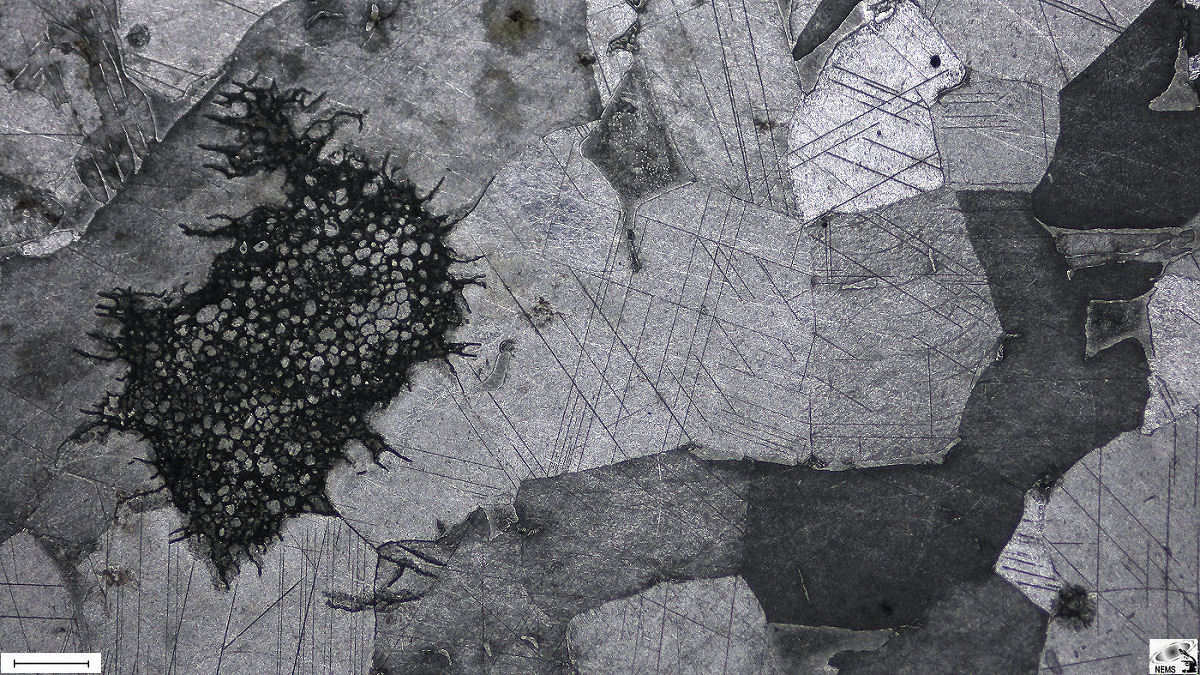|
||
Troilite spiders |
| Listing of Structures |
| Back...Next |
| Meteorite, Willamette, IIIAB iron |
 |
| Figure 1. Scale bar 80 µm. |
| Meteorite, Willamette, IIIAB iron |
| The word "spiders" paired with
meteorites might sound like the premise of a science fiction novel or the
opening scene of a low budget "B" movie. Yet, "troilite
spiders" is a legitimate term used to describe the spidery formations of
the mineral troilite found within certain interior sections of the Willamette
meteorite. These distinctive structures may be key to unraveling the origins of
this 14.5-ton iron meteorite's striking, sculpted appearance. Troilite, an iron sulfide mineral (FeS), is a common component of iron meteorites. In the Willamette meteorite, it appears as large nodules measuring 1-3 cm in diameter, as well as more minor lenticular and lamellar inclusions. The spidery morphology of these troilite formations is a hallmark of Willamette, though not entirely unique. Similar features have been observed in the Willow Creek IAB iron meteorite. Still, they remain a rare and intriguing phenomenon. This spidery structure is readily observable under a microscope, and the question is how these "spiders" formed. The Willamette meteorite, weighing 31,107 lbs. as measured on a railroad scale in 1906 (Hovey 1906), ranks as the 10th largest known meteorite. In his detailed study, Buchwald (1975) describes its structure as "complicated," suggesting it resulted from a series of formative events. He proposes a five-stage model to explain its development: Stage 1: Primary Cooling Following its initial, primary, slow cooling period, Willamette began to exhibit a medium Widmanstätten structure along with nodules and lenticular troilite inclusions. Stage 2: Major Shock and Reheating This stage involved a significant impact event, causing intense shock and reheating. The troilite was shock-melted, penetrating the kamacite and plessite fields in multiple directions. As the kamacite recrystallized, new grain growth began, with grains meeting along plessite fields and troilite filaments. The troilite itself recrystallized, incorporating small particles of phosphides and taenite during the process. Stage 3: Lesser Shock Event A subsequent, less intense impact introduced Neumann lines (shock-induced deformation features) into the recrystallized kamacite. Any reheating at this stage annealed and polygonized the kamacite but was insufficient to trigger a third recrystallization. Stage 4: Atmospheric Passage Willamette's terrestrial age is unknown but is believed to be tens of thousands of years. Weathering has removed all remnants of the fusion crust and any heat-affected zones from its fiery descent. Estimates of physical material lost through ablation are unknown. The next part, Stage 5, pertains to the troilite spiders and may answer Willamette's most unusual appearance. Stage 5: Terrestrial Corrosion and Troilite's Role The meteorite's exterior, measuring approximately 3m x 2m, is marked by a network of cavities and holes, some as large as 65 cm long and 45 cm deep. A 1904 photograph by Ward shows these cavities spacious enough to enclose two children. Unlike regmaglypts, these cavities are likely the result of prolonged corrosion over millennia in the humid forest environment of Oregon's Willamette Valley. Evidence suggests that the troilite in Willamette underwent shock-melting on at least two occasions during its history. The spider-like troilite structures are thought to be the final outcome of this complex sequence of shock-induced transformations, beginning with the original lenticular and lamellar forms. Microscopic analysis reveals numerous filaments radiating outward from the spidery centers of many troilite inclusions. In some cases, these filaments extend through the kamacite, intersecting and cutting into pre-existing plessite fields (a mixture of kamacite and taenite). The spidery troilite filaments likely played a pivotal role in shaping these cavities. They facilitated corrosion processes by creating diffusion pathways through the kamacite, plessite, and taenite. These pathways may have hosted electrochemical cells, driven by dilute sulfuric acid produced from the decomposition of troilite (FeS). This suggests that the troilite-and its distinctive "spider" forms-is a secondary feature, resulting from shock metamorphism rather than primary formation. |

| Figure 2. Scale bar 120 µm. |
| Meteorite, Willamette, IIIAB |

| Figure 3. Scale bar 50 µm. |
| Meteorite, Willamette, IIIAB |
 |
| The main mass of Willamette is at the American Museum of Natural History, NY. |
|
|
| Listing of Structures |